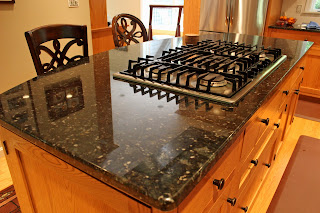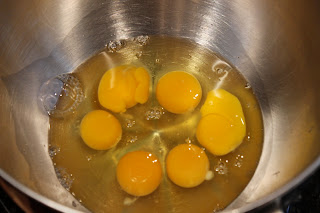Measuring Cups and Spoons: When I was a little girl, my mother didn't use proper measuring spoons. She used the teaspoon and Tablespoon from our silverware when she was baking, so that's what I started out with. I couldn't help but notice that some of our teaspoons were bigger than others. But because she had always cooked that way, she was used to the results she got using this somewhat imprecise measurement. And they were close enough that there wasn't too much of a problem. She also used her pyrex measuring cup to measure pretty much everything.
Then, in Junior High, I had my one and only Home Ec class, and I learned that measuring spoons are more accurate than silverware, that liquids should be measured in the glass measuring cups, but that dry ingredients should be measured in metal or plastic cups designed for that purpose. The first measuring spoons and cups I bought came from the local supermarket and were, shall we say, inexpensive. They weren't pretty, but they did the job.
When I started to really get interested in baking, I bought stainless steel measuring spoons and cups from Williams-Sonoma that look like this:
And to make my life easier, I bought the odd-size groups (1/3, 2/3, 1 1/2 cups, 1/2 Tablespoon, 3/4 teaspoon).
Then, about 10 years ago, Steve and I went on a tour of the Scharffenberger factory in Berkeley (before they were bought out by Hersheys, which is the topic for another blog on chocolate), and in their gift shop I found the Cuisipro measuring spoons that I use most often today. They have a wonderful feel in your hand, and it is easy to level off the top. Besides, they're just pretty to look at:
And about five years ago, OXO came out with their very cool measuring cups that let you see what the measurement is from the top, along with the very useful 1/4 cup measures:
I always felt a little uncomfortable with the glass measuring cups because you had to get down to eye level to see the measuring lines, and the angle seemed to change it appreciably. With the new angled ones, I feel I get much more consistent results.
Scales: Once I got serious about baking, I started reading recipes that talked about weighing ingredients rather than using measuring cups and spoons. That's when things got really confusing, and I still find my self not quite sure at times. Here's the bottom line: many cookbooks are written by people who work in bakeries or restaurants, and in those settings, measurement is always done by weight (Imagine the impracticality of measuring out 32 cups of flour, not to mention keeping track of them). When they write the cookbook, they try to change those recipes into cups and teaspoons, which leads to some errors. The best cookbooks have been kitchen-tested (meaning someone actually cooks the item from the recipe in the book), but too often, there isn't that level of care taken.
When you bake something and it fails (I mean spectacularly fails like the chocolate chip-pecan scones that become one large spreading mass on the cookie sheet that we dubbed the "chocolate chip gooey things" or the pecan bars that cooked over onto the oven which then caused an impressive fire in the oven two days before Thanksgiving when I tried to clean the mess up with the self-cleaning cycle), I think our first impulse is to blame ourselves. After all, we're the amateurs and they're supposed to be the professionals. Now that I have more experience and I can see the patterns in baking recipes, it is easier to recognize whether the problem is intrinsic to the recipe or whether I have made an error.
So back to scales and weighing. There has been a recent trend to give alternate amounts, in weights and measures. On the King Arthur Flour website, there is even a little radio button that allows you to see it either way. And flour is one of the prime ingredients that can convince you to begin weighing rather than measuring. The problem is that flour likes to settle as it sits. I used to just scoop up the flour with the measuring cup, level it, and throw it into the bowl. That measuring style will result in getting more flour than the recipe calls for, because the flour is packed into the measuring cup. Many baking books now recommend taking a spoon and aerating the flour (a fancy way of saying stir a little air into it), then spoon the flour into the measuring cup. They say that will give you an accurate measurement. It certainly is more accurate than the scoop and level method. But a cup of AP flour always weighs 4.25 oz.
The day after I wrote this, the current issue of Bon Appetit arrived. And lo and behold, they had an article on cake recipes, and in the back, under "Prep School," they declared that scoop and level is fine, just aerate the flour with a whisk. Great. So apparently for these particular recipes, the measurements will be accurate with scoop and level. But that got me to wondering what the difference might be. So I measured out 3 cups of flour for chocolate chip cookies (recipe follows), using scoop and level. Then I weighed it. It came in at 14 5/8oz. I have a scale that converts between weights and measures (I know, I know, who else has these things ?), and that is actually 3 1/3 cups + 1 1/2 Tablespoons of flour. Three cups of AP flour would weigh in at 12 3/4oz. That will absolutely make a difference in how your baked goods come out. This is the kind of thing that drives me nuts. How are you supposed to know how they actually measured if they don't tell you???
Another example is sugar. Measuring granulated white sugar with a cup is easy. It doesn't have the packing problem that flour does. However, most recipes that call for brown sugar will say, "packed brown sugar," meaning that you should pack as much as you can get into the measuring cup. It really is easier to measure it by weight. 1 cup of granulated sugar weights 7 oz., while 1 cup of light brown sugar weighs 7 1/2 oz. And the 1 cup measure is supposed to hold 8 oz., right? Are you confused yet?
So I measured out 1 cup of brown sugar, packing it down as hard as I could right up to the edge of the measuring cup. Then I weighed it, and it came in at 6.8 oz and converted to 3/4 cup + 3 Tablespoons. That's not bad, and you might not miss that 1 Tablespoon of brown sugar. But trust me, I really packed it down to get that close.
Butter is always sold by weight. The Lurpak I bake with comes in 8 oz. packages, or if you buy sticks of butter, they're always weighed out to 4 oz sticks, with little marks where the tablespoons are, 8 to a stick. So you already know that there must be 2 tablespoons in 1 oz of butter.
I think the more you can think in both weights and measures, the better off you are. My rule of thumb is: weigh flour, sugar, butter, and shortening, then measure everything else.
CHOCOLATE CHIP COOKIES
This is a double recipe, because you can always find someone to give them to.
1 1/3 cups (9 1/3 oz) unsalted butter, room temperature
2 cups packed light brown sugar (or 15 oz)
2 eggs, room temperature
2 teaspoons Penzey's double vanilla
3 cups AP flour, scoop and level (or 14 5/8oz)
1 teaspoon baking soda
1 teaspoon sea salt
2 1/2 cups chocolate chips or chunks
Optional:
1 1/2 cups toasted pecans or walnuts, chopped
At least an hour or two before you plan to bake, bring butter and eggs to room temperature. You can make your job easier by slicing the butter into pieces and throwing them into the mixing bowl at this time. It's also a good time to toast the nuts, if you're using them, so they'll have a chance to cool (about 8 minutes at 350 degrees F).
Preheat oven to 360 degrees F. Line baking sheets with parchment paper.
Cream the butter and brown sugar in the mixer with the paddle attachment for about 3 minutes on medium speed, until it's light and fluffy. Add eggs and vanilla and beat another 2 minutes until they're completely incorporated and the batter looks light and fluffy again.
In a separate bowl, whisk the baking soda and salt into the flour. Add all at once to the mixing bowl, and mix until evenly distributed, about 2 minutes. Remove bowl from the mixer.
Stir in chocolate chips. If you're going to add nuts, stir these in as well. Using a #40 scoop, which is about 1 1/4 Tablespoons (see the previous blog on the Sugar Cookies about scoop sizes), scoop out twelve cookies per sheet, three across and four down. They need plenty of room to spread.
Bake for 11 minutes total. I like to set the timer for 6 minutes, so I remember to turn the pans mid-way, then I set the timer for 5 minutes. Probably superstitious behavior at this point.
You'll know they're done when the centers of the cookies have risen. Place them on a cooling rack for 5 minutes, then transfer the parchment to the counter top. They need time to set, but if you let them cool completely on the pan, they'll cook too much. Makes about 4 1/2 dozen.
Mom and Steve like these best right out of the freezer. Myself, I like them hot out of the oven.


























































